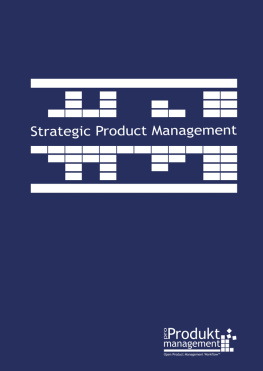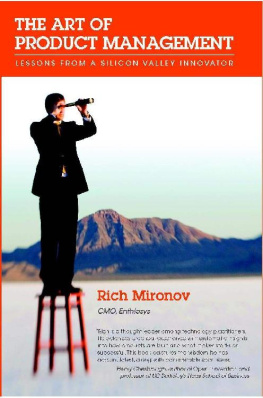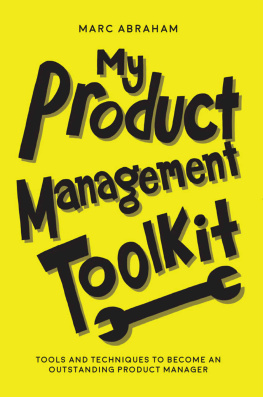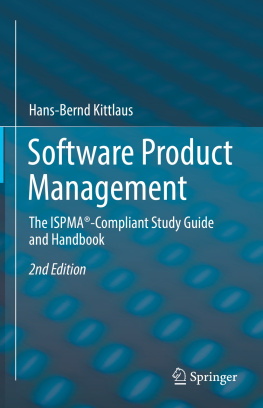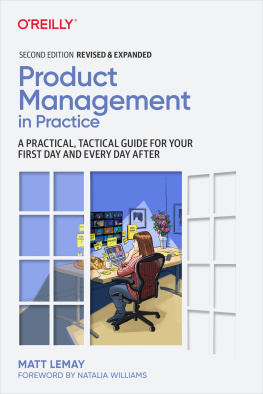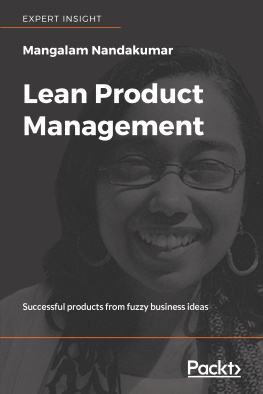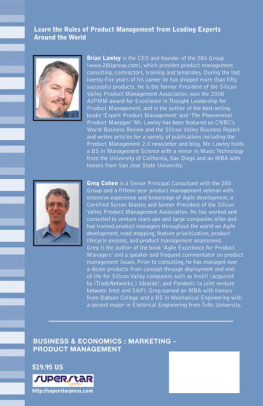MASTER
THE ART OF NO
EFFECTIVE STAKEHOLDER MANAGEMENT FOR
PRODUCT OWNERS & PRODUCT MANAGERS
MASTER
THE ART OF NO
EFFECTIVE STAKEHOLDER MANAGEMENT FOR
PRODUCT OWNERS & PRODUCT MANAGERS
ROBBIN SCHUURMAN AND WILLEM VERMAAK
Copyright: Robbin Schuurman en Willem Vermaak, 2020
Cover: Buro Zeven, Haaften
Inside Work: Buro Zeven, Haaften
Editors: Steve Trapps
Buro Zeven, Haaften
All Rights Reserved.
This book or parts thereof may not be reproduced in any form, stored in any retrieval system, or transmitted in any form by any meanselectronic, mecha- nical, photocopy, recording, or otherwisewithout prior written permission of the authors, except as provided by Dutch copyright law. For permission requests, write to the authors, at info@thevaluemaximizers.com.
Visit the authors website at
https://thevaluemaximizers.com/master-the-art-of-no/
Anonymous
It is easy to say yes. Saying no is what requires real courage.
table of contents
S
SHADES OF NO
Summary
Acknowledgements
About the Authors
Overview of all the Shades of No
Your Own Shades of No
When I was introduced to Master the Art of No by Robbin and Willem, I could not help but smile. The title reminded me of my biggest challenge in life and at work. Being able to say no to people. At home, it results in unhappiness as I buy my children the latest video game, even though it is clearly too old for them. At work, the impact is much worse as I overcommit the organization, make promi- ses that we do not deliver on, and cause large amounts of stress and turmoil for everyone involved. Saying no is, as everyone knows, the most important skill a leader can demonstrate.
So why is it so hard?
I am sure if I asked my therapist he would highlight my childhood, relationship with my mother, and have numerous deep-rooted psychological issues as to why I want to please people. And I am sure he is right. Saying no is being negative and can be thought of as shooting down another persons point of view. When you think about it, saying no to someones idea and desire is very destructive to our relationships if delivered without thought. How many times have you said no to a friend when arranging dinners or nights out only to have those events brought up years later as the reason why you are not as good a friend as you should be? No is a powerful word and should be used with that in mind. But this book is not a book on personal development. It does not provide you with self- help in terms of your desire to be liked, instead, it takes the idea and provides practical guidance in how to operate as an Agile Product Manager / Product Owner. It promotes the idea of creating an environment that not only takes the emotional and people elements out of decision making but provides tools for making the right product decisions. In a way, the book should actually be called, shades of Yes and how to make that possible.
But what has changed in the last years that makes saying no, or building the right product harder now?
Even if it does not feel like it, the reality of modern product development is that we live in a land of abundance. We can change features and channels. We have the opportunity to resegment our customers. We can change packaging, go to market strategies or pricing models. We can integrate, separate, and remix our capabilities. And every year our powers grow as technology, markets, and our customers change. Our biggest obstacles are often not the technology or even the market but our own desire. And we are not alone in this power. Our partners, customers, investors, Developers, and managers have the same opportunities, or they think they do.
Preface - Dave West
SHADES OF NO
As a Product Leader, everyone thinks they can do my job better than me and provides input. In fact, I even encourage this input in Sprint Reviews, customer engagement activities, and the Retrospective. I circulate artifacts like Lean Can- vases and build and share Product Roadmaps. Agile and Scrum, when practiced well, increase the opportunity for inspection and adaptation, which ultimately improves the product. It also increases the number of suggestions and ideas shared with the team. It makes my life as a Product Leader harder, increases my input surface area, and it continually highlights how little I really know about the customer, market, and outcomes I seek. The complexity of Product Owner- ship has increased.
Robbin and Willem are introducing the idea that at the heart of success with Product Ownership is effective stakeholder management. They introduce different categories of saying no, in order to help the Product Owner navigate through the feedback and contexts. This approach is invaluable because feed- back is good, reacting well to feedback is better, and best of all is using the feed- back to drive the next set of product outcomes. But to really take advantage of this approach, you have to work in an empirical, or hypothesis-driven manner.
You have to engage with the stakeholders in the context of learning with the Pro- duct and the Product Increment front and center. You have to work on chunks of value that are small with the ability to change without massive impact. You need to define your work not in terms of absolutes but in terms of questions to answers. When you build a feature it should not be reviewed in terms of does it work, but does the user get the value they seek from it, how does the feature make the customer feel, and what do we now know that changes what we will do next? When you increase the cadence of Sprint Reviews and feedback then the categories of saying no do not just lead to better stakeholder engagement. They also lead to better future work, which in turn leads to better outcomes which lead to better products, which...well, you get it.
It is not about saying no because you want to reduce your work, it is about saying no so you can focus on the right work and iteratively get better in understan- ding your stakeholders needs, customers wants, and investors constraints. Of course, do not take my word for it. In fact, based on this approach you should actually be very skeptical about everything and instead try it, inspect the outco- mes, and see where it leads.
PREFACE
This book is crammed with great tools. These tools range from ways to under- stand the budget to what usability really means to your product. Each one can provide great value, so I recommend trying them. Slowly, incrementally, with a view to learning if they add value to your situation.
A wise man once said, It is not what you do that defines how great you are, but what you do not do. But based on my practical experience I would adapt that saying and add, but deciding what to do or what not to do is very difficult and will often cause you much stress.
Good luck on your journey and enjoy the book.
Dave West
CEO & Product Owner at Scrum.org
Boston, 2020
Agile Manifesto, Principle
Simplicity The art of maximizing the work not done is essential.
Busy, busy, busy! Its one of the common answers you get when asking people how things are going. Youre running from one meeting to the next, in between you have to make a phone call, get a coffee, and then on to the next session. There is a lot to do, but not enough time to do it all. This means its necessary to make choices. Due to the increasing complexity in our daily work, you are not only expected to make more and more choices, but also make them faster.
Next page

